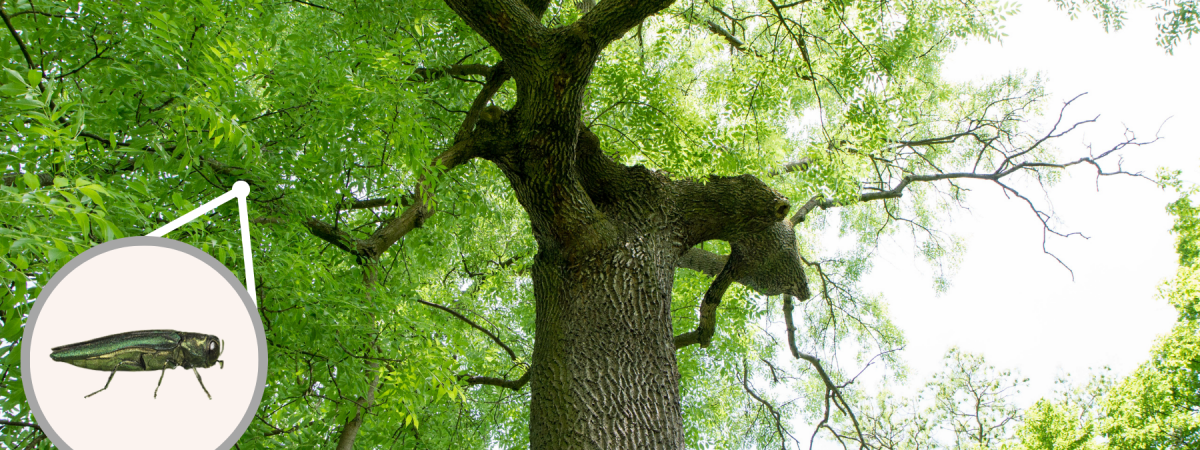Emerald Ash Borer (EAB) Solutions: Safeguarding the Trees on Your Property from the Threat
The threat of Emerald Ash Borer (EAB) has become a major issue for many residents in the Denver Metro area within the last few years. The beetle has shown no signs of slowing down its spread and many untreated/infected trees are showing signs of decline or beginning to die. Many options for management of infected trees and preventative treatments exist and each have their own set of pros and cons. Methods include:
- Trunk Injection Method: Emamectin Benzoate or Imidacloprid
Injection of chemicals is the safest chemical method for treating and managing an EAB infestation. The chemicals applied are contained in the trunk of the tree so there is less of a chance of contamination of other plants or harm from contact by humans or pets.
- Soil Injection Method: Imidacloprid or Dinotefuran
Soil injections of Imidacloprid or Dinotefuran are among the cheapest methods of
treatments for EAB. They are relatively non-invasive and just require turf access around the drip line of the tree. There are some drawbacks.
These drawbacks include:
- Lower efficacy due to low chemical concentration or poor uptake
- Possibility of harm to other insects and pollinators from unintended uptake by other plants
- Re-treatment is needed on a yearly basis
- Spray Method: Bifenthrin or Dinotefuran
Foliar sprays and trunk sprays are also a viable method for management of EAB.
They are most effective when applied prior to the emergence of the adult beetle however they are highly invasive as the area around the tree must be clear of people and pets for the duration of the spray and until the chemical has dried. They also have a lower effectiveness due to the chance of missing the spray window or incomplete coverage of chemicals.
- Removal Method: Remove and Replace The Tree
Removal and replacement of your Ash tree may be a larger financial burden, but
the cost of removal and replacement could be a better choice if the tree is not large or is too far declined for any viable treatments. Replacement trees would be unaffected by EAB due to their species and could save you money on upkeep and treatment costs over time.
- Biological Control Method
Some unmanaged methods of control are predators that may feed on the larval stage. Woodpeckers, in addition to being a method of detection for infected trees, have a significant effect on the mortality of larvae. The downside is that the presence of woodpeckers can cause additional damage to the tree as they try to get to the larvae and that the infestation rate in the tree may be very high and thus too high for the tree to be viable for other treatments.
When choosing a method of protection for your trees there are some important things to note.
- Injectable Chemicals
Emamectin Benzoate is the most effective chemical on the market, it can be administered via a trunk injection with over a 90% effectiveness rate. The treatment is good for up to three years (on average), but most treatment plans are repeated every two years to keep active chemical levels in the tree at a therapeutic level.
Imidacloprid is another chemical on the market which has shown promising protection rates against EAB. It is the only chemical on the market that is also available to consumers for at home treatment methods, however it is sold at a less concentrated mixture rate and is usually applied via soil drench in these products which can lead to runoff of the chemical and can cause harm to other insects if absorbed by other plants. These treatments also need to be repeated every year to maintain efficacy against the beetle.
- Firewood
Keeping firewood in the location of the tree that was removed can cause further
spread of the beetle to other healthy trees. Chipping of the material is ideal as infested wood can spread beetles for another cycle even after removal.
If firewood is kept it must be covered and sealed with a clear tarp for at least one year, debarked to prevent larvae from maturing into adults and emerging or it must be kiln dried to kill remaining larvae and eggs. It is also highly recommended that firewood not be moved from where it is cut; this will prevent the spread of eggs and future adults that can then infect other trees.
EAB is moving into south Denver and has been detected in Littleton, Co. At Splintered Forest we are here to prevent the spread to the ash trees on your property. Our team of Arborists and Plant Health Care professionals are available to provide free estimates to help keep your trees healthy and your landscape beautiful. Give our team a call today at 303-819-9840 or visit Save My Ash for a free estimate for EAB Injections.
Read more: Understanding the lifecycle of the emerald ash borer (EAB) and how it is crucial for effective tree management.

